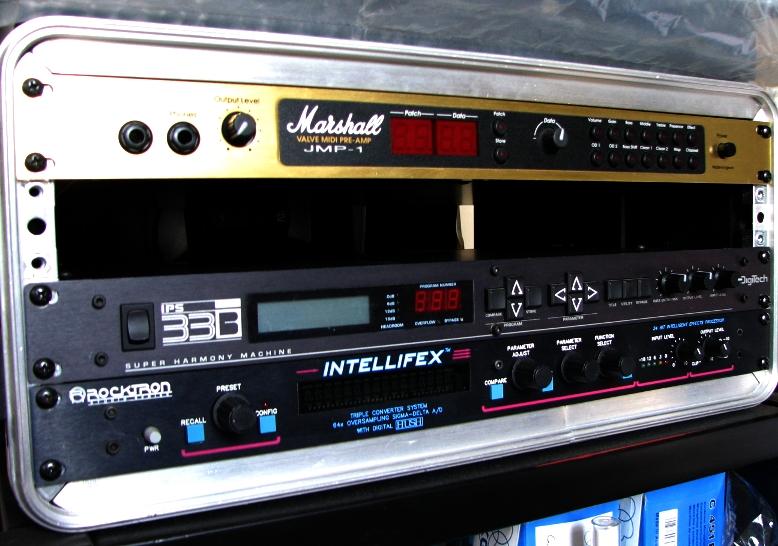A Nice Little Windfall Comes My Way
I've got a really great guitar friend named Joe at work, the kind of guy who you love to do the water cooler thing with. We share our latest fingerboard discoveries and conquests and the music we are listening to and ask each others' advice on various stuff. The other day I got an email from Joe entitled "Toys." It seems that one of his old playing buddies had made the move back to combo amps from racks a while back and after storing his old rack stuff for a while, his buddy was cleaning out his storage, and thought of Joe. This happened once before and Joe ended up with a really nice Strat as a gift. This time it was his buddy's guitar rack set-ups:
- One Marshall JMP-1 Valve MIDI Preamp (tube preamp with MIDI control designed to be fed by preamp and feed speakers)
- One Rocktron Intelliflex 24-bit Intelligent Effects Processor (MIDI controllable effects processor)
- One Digitech IPS33B Super Harmony Machine (MIDI controllable harmonizer)
- One Tube Works MV-962 MosValve Power Amp
- Two SKB 4-rack-unit rackmount cases
- One Rocktron MIDI Mate MIDI Foot Controller with a road case full of patch cords
Because he plays mostly acoustic guitar, bass, and keys, Joe allowed that has no use for most of this. Knowing that I do play a quite a bit of electric and do some sessions, Joe graciously wondered if I would have a use for any or all of this gear? (!) Now, I bypassed the '90 rack gear phase because of the expense and being in the middle of raising a family during their heyday. I stayed with my little combos through the rack years but as an engineer had encountered similar gear in the studio. After their experiences with rack, many friends had told me that rack gear sounded very dry. But being inquisitive, I always wondered what I could do with some of this stuff. This week, along came the opportunity to find out. Joe brought me the gear in its road cases. Thanking him profusely, I took the gear home in my trunk, downloaded the manuals, and dived in.

The first thing I tried was the Marshall JMP-1 Valve preamp (top unit above) because it is considered such a classic. As many of you know, whether combo or head, standard guitar amps consist of a preamp and a power amp combined into one chassis. Rack systems break out those components into separate units, allowing you a little more choice. For my first experiments I drove the preamp rack into my Marshall combo. I've had a Marshall JTM-60 combo amp for several years but was never satisfied with its drive channel. At the time it was built, Marshall was experimenting with a sound that was a crossover between the Marshall and Fender sounds. The resultant overdrive seemed a little buzzy or fizzy to me. The amp has a nice, glassy clean channel and lots of ins and outs including a series loop that allows direct access to the power amp. I connected up the JMP-1 to the combo's EL-34-based power amp and -BAM!- instant classic Marshall sound. I was able to access the sounds I wanted very quickly: With a few tweaks I can transit from JTM-45 clean to modern glassy clean to model 1987 drive to model 1959 Super Lead burn. Zing! The Marshall tube power amp gave it a nice, warm sound and the preamp's Bass Shift control makes the 1x12" combo cab sound much larger than it is. Most importantly, I was able to dial in MY Marshall sound, a round sound without a lot of ice pick and overtones. This will be great for recording! Of course, the unit allows you to save your tone patches and the Rocktron MIDI foot board allows you to call up those patches instantly for live use.
Next came the Rocktron Intellifex multi-effects unit (bottom unit above). I connected it into the loop of the JMP-1. So far I've investigated the delays and reverbs and find that both are quite reasonable. This isn't a tape delay, but it is highly tweakable (and as a recording engineer, I am, sort of, by definition a tweaker ) to make some nice sounds. And that, folks, is the majority of my sound: a little delay, a little reverb. Voile'! I'll start checking out the modulation effects next.
So, I'm slowly climbing the learning curve at night, working my way through the manuals, and learning to "work" the various units. The biggest challenge will be to make room for all of this in my little home studio.
It's really nice to have such a good guitar friend and it is a real thrill to have these tools drop in my lap as a gift. Thanks, Joe!
= =
=

